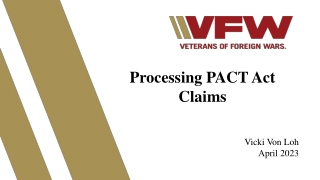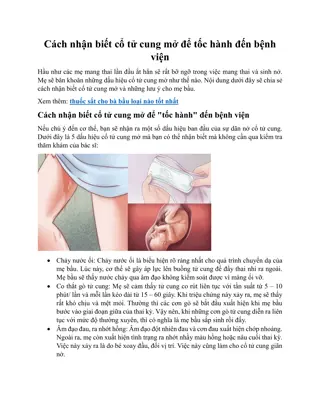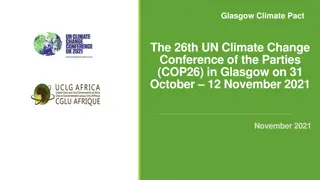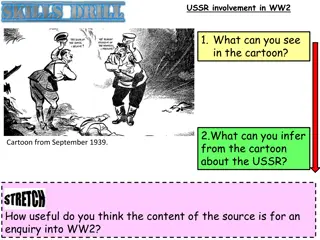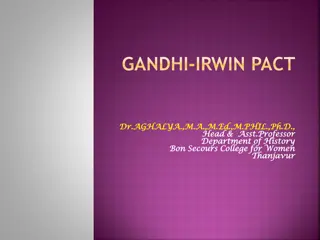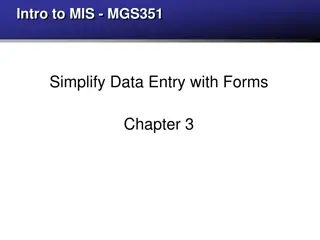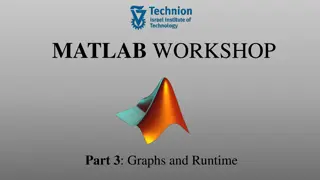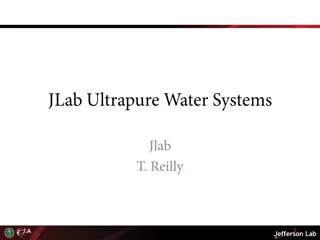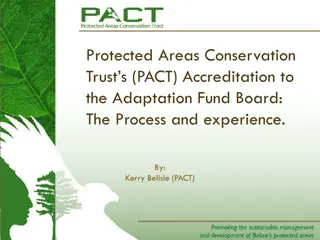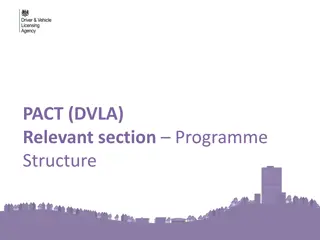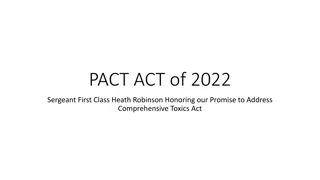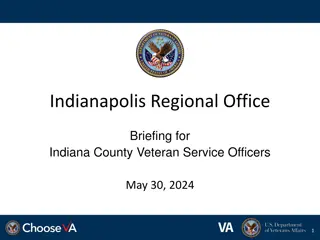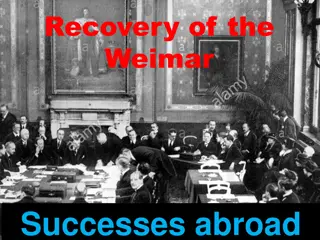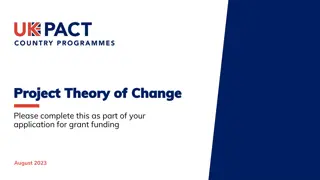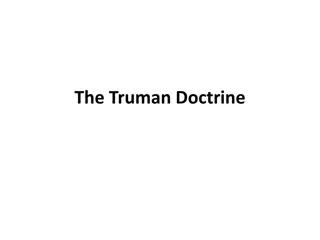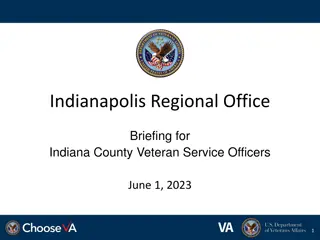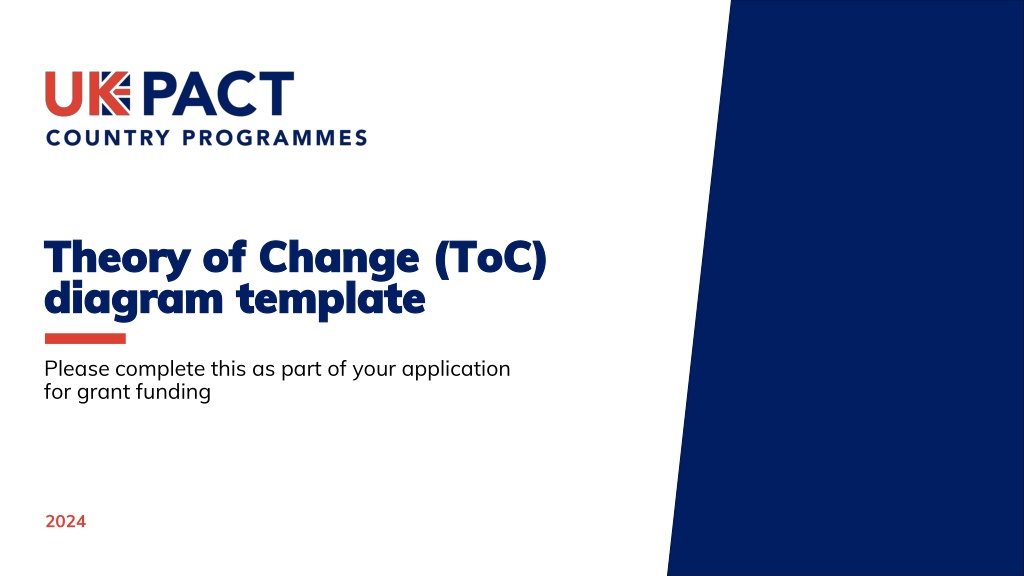
Effective Theory of Change for Grant Funding 2024
Understand the importance of a Theory of Change in grant funding applications. Learn how to create a comprehensive pathway for achieving desired changes over time. Follow instructions on completing a ToC diagram with clear assumptions and detailed titles. Start building your project's activities, outputs, outcomes, and impacts for successful tracking and evaluation.
Download Presentation

Please find below an Image/Link to download the presentation.
The content on the website is provided AS IS for your information and personal use only. It may not be sold, licensed, or shared on other websites without obtaining consent from the author. If you encounter any issues during the download, it is possible that the publisher has removed the file from their server.
You are allowed to download the files provided on this website for personal or commercial use, subject to the condition that they are used lawfully. All files are the property of their respective owners.
The content on the website is provided AS IS for your information and personal use only. It may not be sold, licensed, or shared on other websites without obtaining consent from the author.
E N D
Presentation Transcript
Theory of Change ( Theory of Change (ToC diagram template diagram template ToC) ) Please complete this as part of your application for grant funding 2024
Instructions and key definitions
Introduction Introduction What is a Theory of Change? What is a Theory of Change? A Theory of Change is a comprehensive description and illustration of the hypotheses for achieving a desired change over time in a specific context. It maps out the steps needed to achieve long-term goals by identifying the pathway and relationships between activities and different levels of results, from outputs to intermediate outcomes, and finally to the project s impact. A clear Theory of Change provides the following: A clear and testable hypothesis about how change will occur that allows you to be accountable for results. A visual representation of the change you want to see and how you expect it to come about. A blueprint for evaluation with measurable indicators of success identified. An agreement among stakeholders about what defines success and what it takes to get there. A powerful communication tool to capture the complexity of your initiative. For more information, visit www.ukpact.co.uk
Instructions for completing your Instructions for completing your ToC ToC diagram diagram Link boxes horizontally with arrows to illustrate the chain of results from activity to output to intermediate outcome to outcome. Arrows have been provided to illustrate how they should be used. Results at all levels should express an achieved activity or result rather than an ongoing action or process. 1 2 3 4 5 6 7 8 Clearly state the assumptions underpinning each step in the results chain, and their potential impact on the project s results. This will help in understandin g the underlying factors that could influence the success of the project. Complete the template on slide 8, for your project, adding or deleting boxes where necessary and providing detailed titles for each activity, output, intermediate outcome, outcome and impact. Specify the targeted timeframes for the completion of each result. This will help in tracking progress and ensuring timely achievement of project goals. Once you have completed your ToC diagram, please submit it with your proposal and complete sections 5 and 6 in the Technical Proposal Template. If you need more space, you may copy the template to an additional slide, however in this case we are looking for quality not quantity. Define your intended impacts and work backwards, filling out outcomes, intermediate outcomes, outputs and activities. Start filling out the information about the problem and activities that you are planning to deliver. For more information, visit www.ukpact.co.uk
Key Definitions (1) Key Definitions (1) Activities: actions you must complete to achieve project success by converting inputs into specific outputs. Usually consisting of tasks and subtasks that all contribute to the activity's completion. These are the activities that must be listed in your Project Workplan. UK PACT Output Areas: 1. Skills enhanced and capacities built: Individual and institutional skills and capabilities are built for the design and implementation of enhanced and inclusive climate actions. Outputs: are the products, deliverables or services resulting from project activities. Outputs are within the direct control of an intervention and are normally provided to the project s key counterparts or other project stakeholders. Outputs are the basis from which the desired change will occur, e.g., trainings delivered, policy recommendations produced, knowledge generated and shared, tools developed and piloted, etc. Note that all outputs on UK PACT projects should be categorized using one of the four programme output areas: 2. Innovative models, including policy, accelerated and/or piloted: New or enhanced tools, technologies, policy recommendations and best practices are developed, piloted or integrated into existing frameworks. 3. Knowledge, evidence and learning generated and shared: Production and dissemination of new knowledge, evidence and learning to support enhanced and inclusive climate action. 4. Partnerships and networks established and strengthened: Convening stakeholders to coordinate action, foster collaboration, share learning, and more widely inform enhanced and inclusive climate action. For more information, visit www.ukpact.co.uk
Key Definitions (2) Key Definitions (2) Intermediate outcomes: The jump from outputs to outcomes in capacity building and policy change interventions can be significant. Intermediate outcomes can help track progress towards outcomes, by providing interim indications of the initial uptake and application of project outputs by target stakeholders. Intermediate outcomes are what we most commonly expect to see, measure, and report after an output has been delivered. They reflect the specific skills, knowledge, networks and capacities stakeholders wish to build or enhance, and how they intend to act upon these. Be specific and clearly define the expected change Use measurable terms (that can be quantified or assessed) Ensure the outcome is attainable within the project s scope and resources Specify when the outcome should be achieved Align the outcome with broader goals of the project Impacts: Impacts are the long-term, high-level and significant changes or goals to which your project is expected to contribute. These changes can be social, economic, environmental or institutional and reflect the broader, often transformative changes of project delivery. Outcomes: Outcomes are the specific and measurable short to medium-term changes in target systems, organisations, institutions, behaviours, conditions, capital flows, relationships, or arrangements that project outputs are expected to result in. Outcomes are not always delivered during the lifetime of a project, but evidence of progress towards them should be seen. Projects can have one or several outcomes, however it is recommended that the projects do not have more than three outcomes. Tip: For writing effective impact statements make sure to: Be specific and clearly describe the significant change or effect Highlight the broader, long-term changes Include quantifiable indicators to demonstrate the impact Describe why the impact is important and who benefits Tip: For writing effective outcomes and intermediate outcomes statements make sure to: For more information, visit www.ukpact.co.uk
ToC template for completion
Your project The change Intermediate outcomes What are the short-term changes in behaviours, practices, or conditions that occur as stakeholders begin to adopt and implement the outputs? Outcomes Problem Activities Outputs Impact What are the wider mid-term changes that will result from your project outputs? What is the problem you are trying to solve? Which are the activities that you are planning to deliver? What are the key direct measurable effects of your activities? What is the long-term goal your project contributes to? A1. A2. A3. A4. A5. A6. A7 A8. A9. A10. A11. A12. A13. Assumptions Assumptions Assumptions Assumptions Target timeframe Target timeframe

